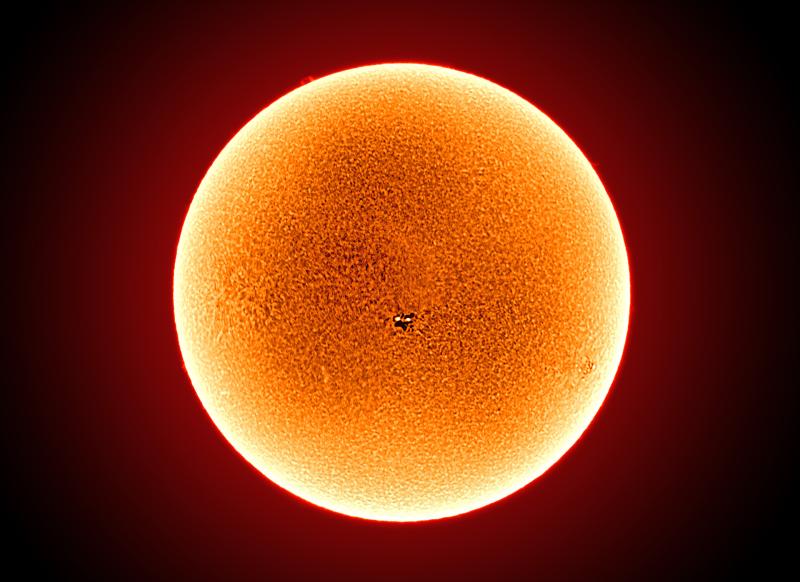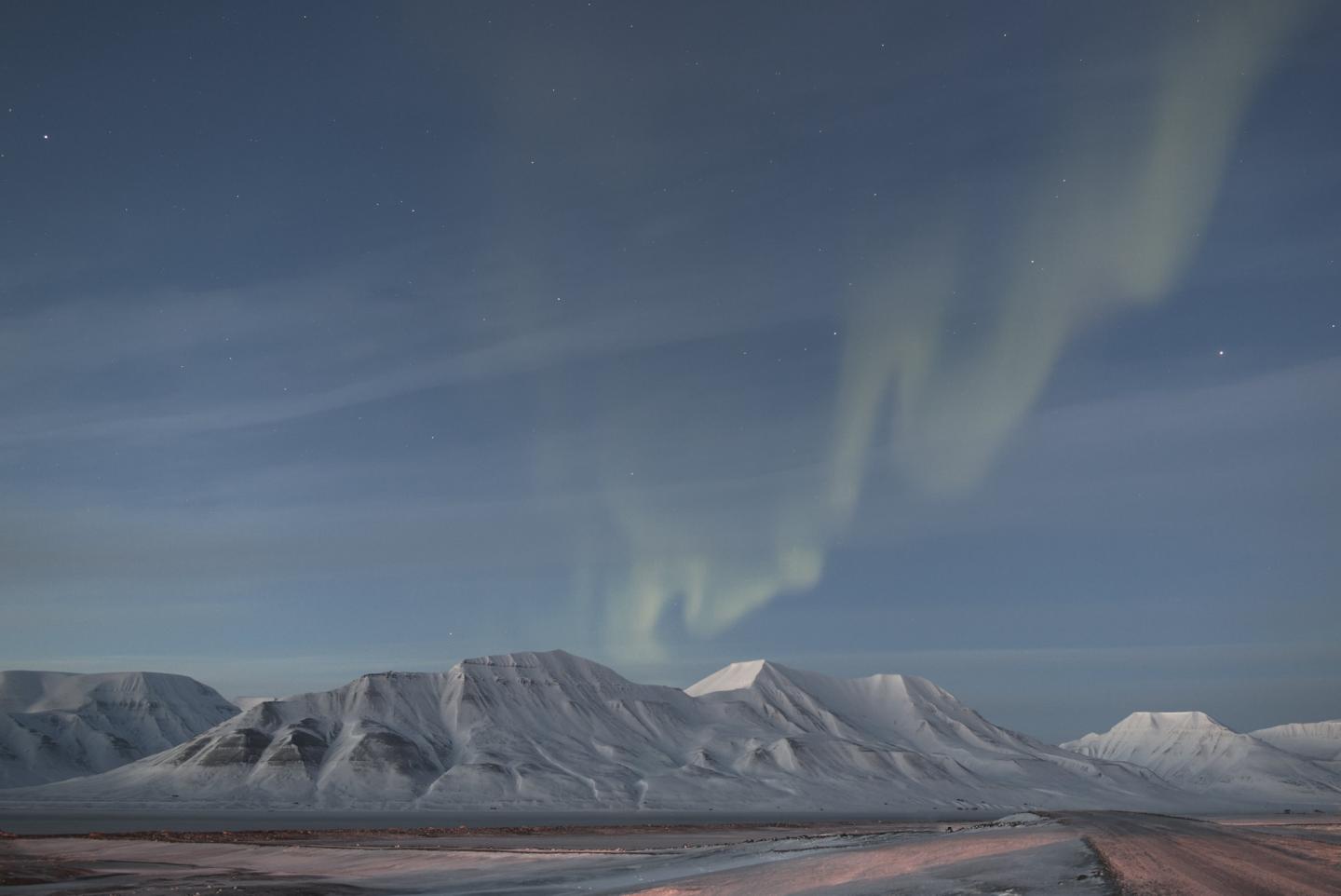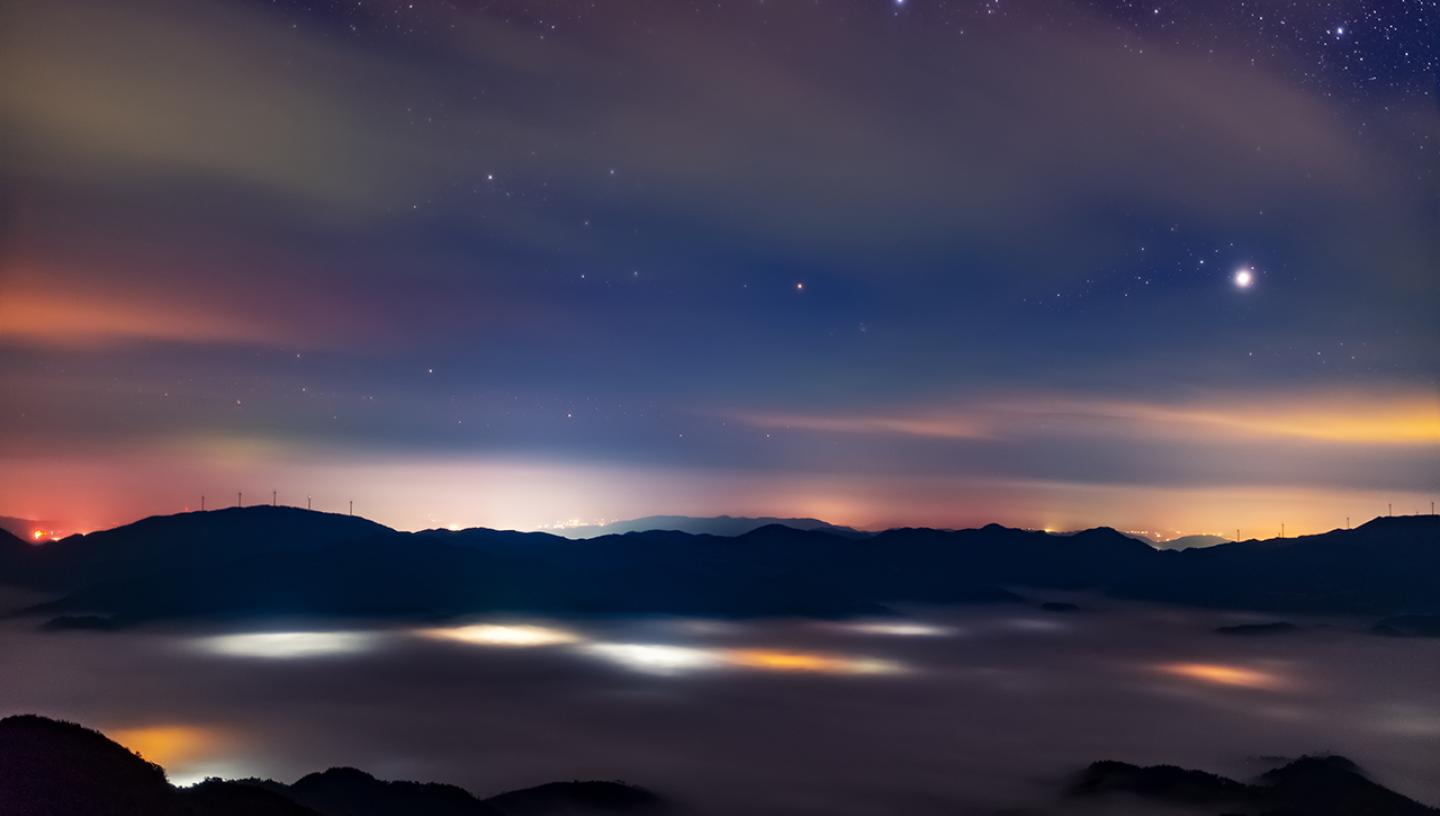
Want to get into astronomy without buying a telescope or binoculars?
It may surprise you just how much you can see in the night sky with the unaided eye.
While optical aids allow you to examine astronomical objects in more detail, there's plenty to get excited about if you're just getting started in astronomy and aren't ready to spend money.
Hear from Royal Observatory Greenwich astronomers to find out what you could possibly see, including meteor showers and comets, galaxies and star clusters, lunar features and more.
Just bear in mind that many night sky sights depend on good seeing conditions. This means dark clear skies away from too much light pollution (that includes the full Moon!). But don't worry if you're in the city: some of the examples below can be seen even in the brightest urban areas.
Top tips for stargazing with the naked eye
For the best chance of seeing night sky sights without a telescope or binoculars, find somewhere away from buildings and street lights if you can.
Allow your eyes to adjust to the darkness for at least 15 minutes, avoiding any bright sources of light like your phone screen. If you’re struggling to find your way around you can use a red light torch, which won't disrupt your eyes as you're adapting to the dark.
A planisphere or stargazing app can help you identify what you’re looking at, or direct you where to look to see a certain target. If you opt for an app, put a red filter on it.
The Moon can be a pain for naked-eye stargazers. As it reflects sunlight, it causes natural light pollution which can prevent you seeing fainter objects. The best time to stargaze is around the new Moon phase. However, if the Moon is bright all is not lost - you’ll still be able to see brighter objects in the sky and, of course, enjoy the Moon itself.
The 'averted vision' technique may help you see fainter objects in the sky. Instead of looking directly towards the object, look a bit to the side and concentrate on the target.
Why can you see things better in the night sky if you don't look directly at them? Our eyes have two main types of cells: 'cone' cells detect colour and fine detail, and work most effectively in bright light; 'rod' cells provide better vision in low light conditions. Cone cells are concentrated around the middle of the eye while rods are concentrated around the edges - which is why, when stargazing, some people find that 'averted vision' allows them to see their targets better.
Stars, constellations and asterisms
Throughout history humans have looked up at the night sky and identified patterns in the stars. Different cultures gave names to these patterns to make them distinctive and easy to remember. Many of these are the constellations we know today.
The names for constellations commonly used in the UK and Europe are usually associated with Classical myths, legendary figures like Orion and Hercules, and animals such as the Great Bear Ursa Major.
Constellations appear from our perspective to move throughout the night and throughout the year as Earth spins on its axis and makes its way around the Sun.
In dark areas you’ll be able to see them easily unaided, while from light-polluted areas some of the brightest stars in constellations are visible with the naked eye.
Asterisms, meanwhile, are recognisable groups of stars within constellations or formed from the stars of multiple constellations, such as the Plough or Orion's belt (see below).
Here are some of the most recognisable constellations, stars and asterisms you can see. Read our monthly night sky highlights to find out if any notable constellations and stars are visible this month.

The Plough
The brightest stars within the constellation of Ursa Major, or the ‘Great Bear’, form the Plough asterism. Also known as the Big Dipper, this group of stars resembles a saucepan with a handle.
From the Northern Hemisphere this constellation is circumpolar (meaning ‘around the pole’), so you’ll be able to see it all year. It usually stands out distinctly in dark and slightly light-polluted skies.
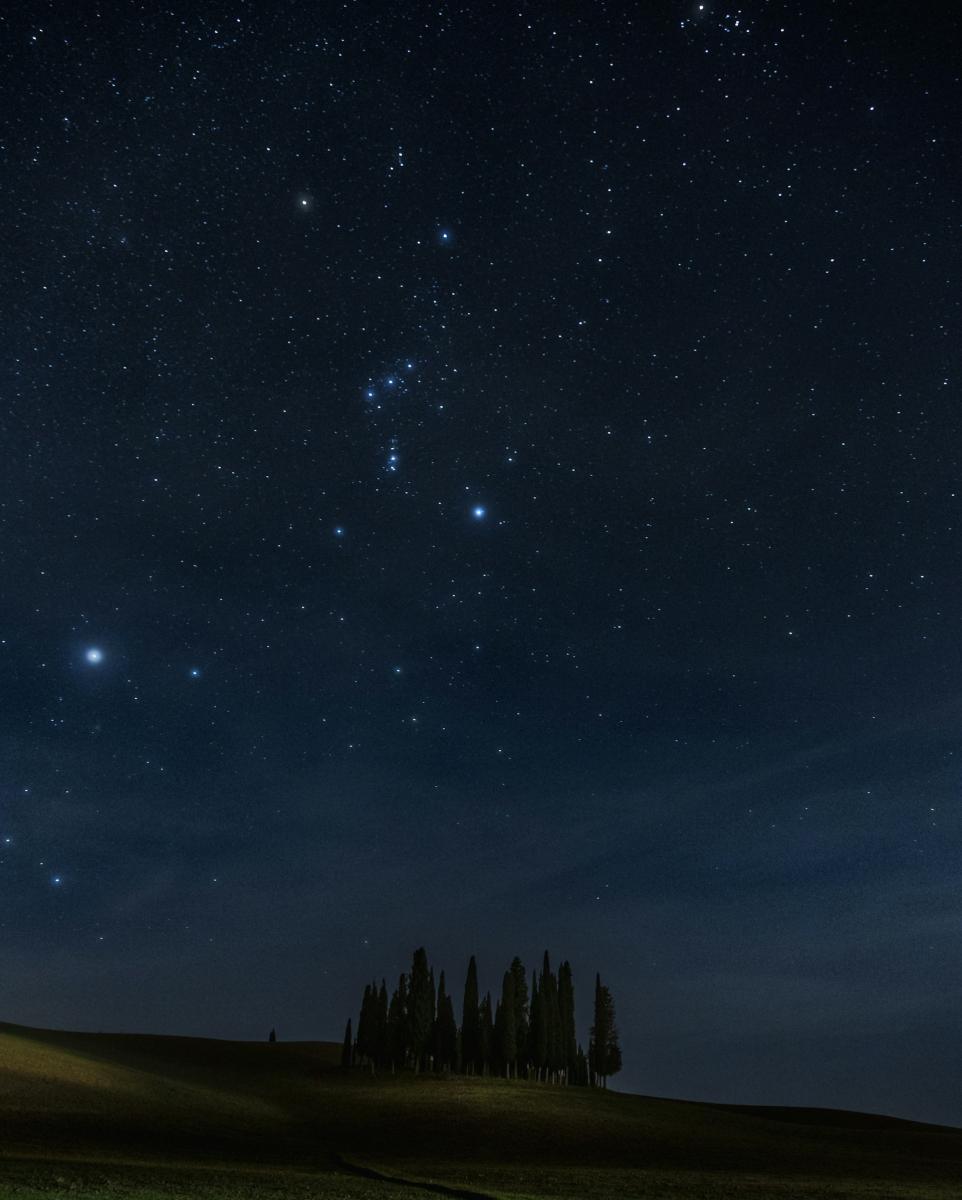
Orion and its neighbouring stars
This famous winter constellation for the Northern Hemisphere depicts the Greek mythological figure of Orion the Hunter, holding a raised club in one hand and a shield (or a lion’s head) in the other.
Orion's belt is one of the most recognisable asterisms, and can be seen even in light-polluted areas. It’s made up of three very bright stars (Alnitak, Alnilam, and Mintaka) which form a straight line.
Orion's foot is the bright star Rigel, a blue supergiant and the seventh brightest star in the sky.
Orion's western shoulder is Betelgeuse, a red supergiant star which is deep orange-red in colour.
Diagonally to the left of Orion, the bright star you can see in the image is Sirius. Sirius resides in the constellation of Canis Major (the Great Dog), and is the brightest star in the night sky. It's so bright as it’s relatively close to Earth, only around eight and a half light years away. Sirius occasionally appears to ‘flash’ red and blue, which is caused by its light passing through Earth’s atmosphere.
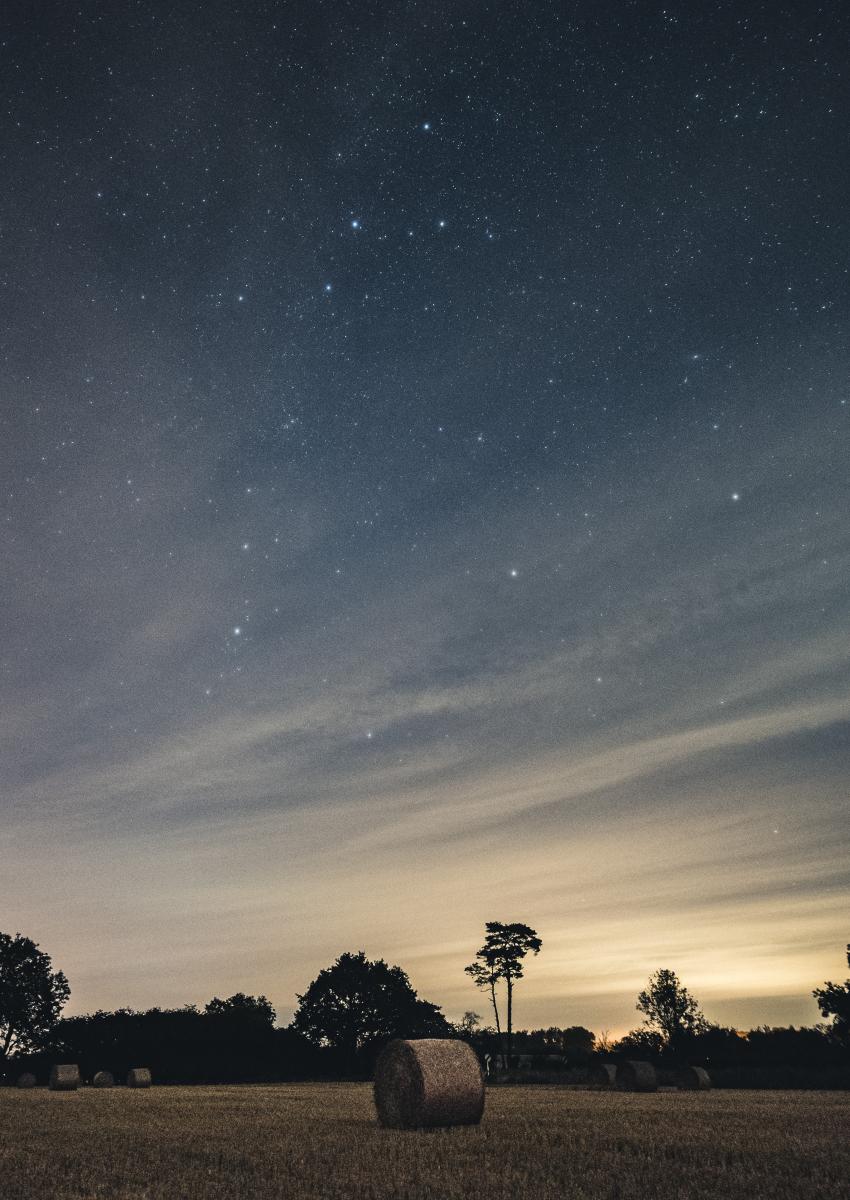
Cassiopeia
The constellation Cassiopeia resembles a zig zag, which at some points looks like a W and others an M depending on the time of year. In the Northern Hemisphere it’s circumpolar, so you’ll always be able to see it on a clear night.
The Winter Triangle and the Summer Triangle asterisms
The Winter Triangle is made up of the stars Betelgeuse (in Orion), Sirius (in Canis Major), and Procyon (in Canis Minor), making a neat and almost perfect equilateral triangle. All three are bright stars, meaning this is easy to spot even in light-polluted areas.
The three bright stars which make up the Summer Triangle are Deneb, Vega and Altair. This asterism is well suited for summer observing when dimmer objects become increasingly difficult to make out.
Star clusters
Star clusters can be one of two types: open or globular. Unlike constellations, star clusters are gravitationally bound together (rather than just appearing close to each other from our viewpoint on Earth).
Open clusters are less dense collections of stars, normally more recently formed from stellar nurseries. Globular clusters are more densely packed regions of old stars.

The Pleiades
One of the most easily recognisable open star clusters in the night sky is the Pleiades, also known as the ‘Seven Sisters’.
Glowing a cool blue, the Pleiades' brightest stars are radiant enough to be seen with the naked eye even from light-polluted areas, though averted vision might be helpful here. While around six or seven are visible unaided, there are actually over 1,000 stars in the cluster.
You can find them when they're visible from your location by following the straight line of Orion's belt (see above), to a bright reddish star called Aldebaran, and on to where these blue gems live.

The Hercules Cluster (M13)
A famous globular star cluster that you can see in clear, dark skies with the unaided eye is the Hercules Cluster, also known as M13 (pictured). As the name suggests, you’ll find it in the constellation of Hercules.
Omega Centauri
The Milky Way’s biggest and brightest globular cluster visible from the Southern Hemisphere is Omega Centauri, also called NGC 5139. This group of around 10 million stars is roughly 15,500 light years away, with stars up to 12 billion years old. You can find it within the constellation of Centaurus and it will resemble a fuzzy blob.
The Moon
The Moon is one of the most visible and striking things you can see with the naked eye in the night sky.
Our beautiful celestial neighbour is an almost ever-present spectacle, changing in phase, location, colour and size on a regular basis. But what details can you see on the Moon's surface without a telescope?

Maria
The dark patches you can see on the Moon are called maria, which means ‘seas’ in Latin.
Ancient astronomers saw these dark areas and thought they were made of water. Today we know the truth: these are actually huge hardened lava plains, made up of volcanic rock. This rock is less reflective than other parts of the lunar surface, causing the difference in colour.
Supermoons
The Moon has an elliptical orbit, which means that at points in the month it will be closer to us, and at other points farther away. When the Moon is full and closest to Earth in its orbit, we call it a ‘supermoon’. Supermoons can appear up to 14% bigger and 30% brighter to us than when it’s farthest away.
There is also the less celebrated (and arguably more disappointing) 'micromoon', where the Moon looks particularly small.
Lunar corona
When wispy, thin clouds pass in front of a bright Moon, moonlight can be scattered through the water droplets and cause hazy rainbow rings known as a lunar corona.

Lunar eclipses
During a lunar eclipse, the Moon moves into the Earth’s shadow. There are three types of lunar eclipse, depending on which part of the Earth's shadow the Moon moves into, and all are visible without equipment.
- Total: where the whole Moon is in the darkest part of the Earth’s shadow (the umbra).
- Partial: where the Moon passes through the Earth's penumbra (the outer region of the Earth’s shadow), and only a section of it passes through the umbra.
- Penumbral: when the Moon travels only through the penumbra.
The more of the Moon that is in shadow, the more spectacular the eclipse will be. During a penumbral eclipse for example, there will only be a slight darkening of parts of the Moon. During a total eclipse by contrast the Moon will turn a red hue, because the light that falls on it has been distorted by Earth's atmosphere.
Lunar halos
A lunar or moon halo is where a distinct ring of white light appears around the full Moon. Usually occurring in cold or polar regions, this is caused when moonlight bounces off ice crystals high up in the atmosphere.
Never miss a shooting star
Sign up to our space newsletter for exclusive astronomy highlights, night sky guides and out-of-this-world events.
Satellites
Artificial satellites are human-made objects in orbit around Earth. What we mainly see with the naked eye is sunlight reflecting off giant solar panels that convert the Sun's rays into power for the spacecraft.
The International Space Station
You won’t be able to make out the modules that make up the International Space Station (ISS) with the naked eye, but you can still see sunlight bouncing off its solar panels as it zooms through the sky 400km above us.
NASA has an online ‘Spot the Station’ app and guide to help you find the ISS. After you put your location into the app, it will tell you when the station will next pass over as well as exactly where to look.
It’s a special sight to see the huge floating laboratory, one of humanity’s most complex engineering feats, passing overhead, and imagine the astronauts on board looking down from the iconic Cupola window.
Starlink and other satellites
If you see a pinpoint of light moving quickly through the sky, it could well be one of SpaceX’s Starlink satellites or a range of other similar human-made satellites.
Satellites sometimes appear on stargazing apps, so you can watch them making their way around the Earth.
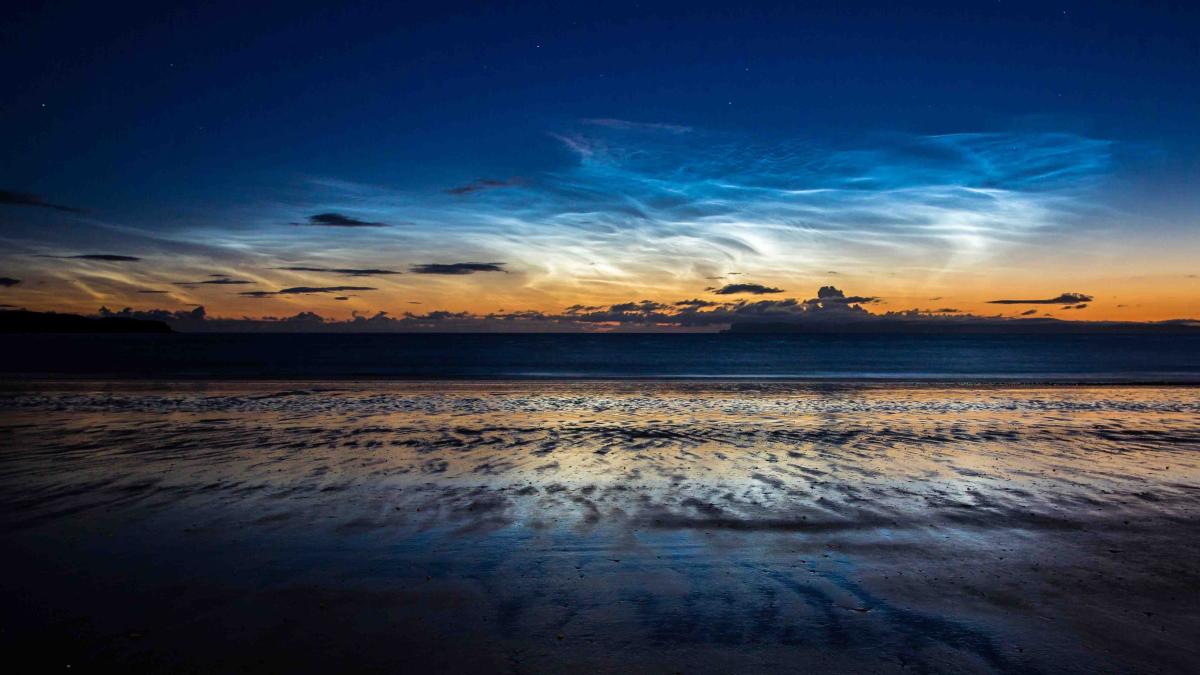
Noctilucent clouds
Noctilucent clouds are clouds that seem to shimmer silver, and are a rare and beautiful phenomenon that occur very high up in our atmosphere. They are most commonly observed during the late evening or early morning hours, when the Sun is just below the horizon but still illuminating the clouds from below.
These appear during summer in each hemisphere, though Southern Hemisphere sightings are much rarer.

Nacreous clouds
Nacreous clouds, also known as ‘mother of pearl’ clouds, are a rare phenomenon that appear under certain conditions. They're usually spotted in polar regions, but can appear as far south as the UK, and truly delight viewers when the conditions align.
Usually appearing post-sunset and pre-sunrise, nacreous clouds are famed for the vibrant colourful hues they reflect, which have been likened to the effect of oil on water.
Meteor showers
Meteors or 'shooting stars' are caused by Earth spinning into space debris left over from comets or asteroids.
These small particles are moving very fast relative to the Earth. When they enter the Earth's atmosphere they are completely evaporated, and the air in the path of the meteor is ionised. We see streaks of light caused by the radiation from the ionised gas and the white-hot evaporating particles.
You don’t need any optical aids to see meteor showers - quite the opposite! Meteors are quick and occur in a wide patch of the sky, so you need a wide field of view which a telescope or binoculars can't provide.
Meteors can appear at any time, but this meteor shower calendar provides the dates of various 'showers' or periods of high meteor activity throughout the year. Here are the ones that you’ll have the best chance of seeing:
Perseids
Occurring mid-July to late August, the Perseids are one of the most famous showers and hailed as one of the best displays to see all year. Thanks to this shower's occurrence in the Northern Hemisphere's summer, it's also one of the more comfortable to head out and watch. Each year at its peak the shower has a predicted rate of around 100 meteors per hour, although the number can vary year on year.
Geminids
The Geminid meteor shower is another showstopper. Their wintry timing in December means more hours of darkness to observe, though frosty temperatures may limit how long you want to stand outside searching for meteors! Luckily there'll be plenty of meteors for you to try to see: the Geminids have a predicted maximum rate of 150 meteors per hour.
Quadrantids
Hot on the heels of the Geminids, the Quadrantid meteor shower at the turn of the year could involve up to 110 meteors per hour on a clear night. You're also more likely to see some colourful or 'fireball' (especially bright) meteors.
The Milky Way
Our galaxy, the Milky Way, is a barred spiral galaxy made up of billions of stars, gases and dust.
The stars are mostly grouped into a flattened disk with a bulge at its centre. The Solar System sits slightly towards the edge of one of its spiral arms.
From our vantage point, when we look towards the Milky Way's centre and it is above the horizon, we see it as a kind of 'band' or strip in the sky.
Most of the stars are too faint to be picked out individually, meaning we see their combined light as a faint glow.
With the naked eye under dark skies you won't see the vivid colours you see in photos of the Milky Way. Instead you will see the Milky Way in monochrome, where it will resemble fuzzy patches of light in a straight-ish strip or line. You'll need dark skies and dark-adapted eyes to be able to pick it out in the sky.
Planets
With the naked eye, many of the planets look like white points of light which vary in brightness, with the exception of Mars which has an orange hue.
You can distinguish planets from stars by seeing whether they 'twinkle'.
Stars twinkle because the light from them gets bent or 'refracted' by the air in our atmosphere, causing them to flicker.
Planets don't twinkle. Because they are inside our Solar System and therefore much closer to us, they appear as tiny discs rather than single points of light. With more light rays being distorted all at once, any twinkling is cancelled out.

Mars, Jupiter, Venus and Saturn can all be seen easily with the naked eye, although you won’t be able to see any detail on them like Jupiter’s Great Red Spot or Saturn's rings. Their moons are also not visible to the unaided eye.
Venus is the brightest planet, and the second brightest object in the night sky after the Moon, so it’s usually quite noticeable.
Uranus is just about visible without equipment under dark skies when it's higher up in the sky, but even then will be a dim spot of light.
Mercury is one of the most challenging planets to find, as it’s never too far from the Sun. However, Mercury occasionally reaches its greatest 'elongation', the farthest from the Sun it is possible for it to reach. Even at elongation you may struggle to spot this little planet.
Neptune, meanwhile, is unfortunately too faint to be seen with the unaided eye.
Planetary conjunctions
A conjunction is where two objects appear close together in the sky or almost appear to touch from our viewpoint on Earth, although they’re very far away from each other in reality.
Occultations
An occultation is when, from our perspective, one celestial object appears to move in front of another, temporarily hiding it from view. For example, a lunar occultation of Mars is when the Moon appears to pass in front of Mars.
Planets at opposition
Planets farther away from the Sun than Earth appear their largest and brightest when they’re at 'opposition' – when Earth is directly between the planet and the Sun. This makes being at opposition the best opportunity to see or photograph the planet.
Solar eclipses
Firstly, it's important to say that you should never look directly at the Sun with the naked eye, or point a telescope at the Sun without a solar filter attached.
Even during a solar eclipse light from the Sun can damage your eyes, and you should wear special eclipse glasses (not normal sunglasses). The only time the Sun is entirely 'black' is the brief moment of totality during a total solar eclipse, when the Moon fully covers its face and plunges a patch of the Earth into darkness.
A pinhole projector is an alternative to eclipse glasses, allowing you to safely see a partial or total solar eclipse with the naked eye. This projects the shape of the Sun and the bite taken out of it by the Moon onto a piece of card.
Aurora
The aurora's famous dancing curtains of light are caused by electrically charged particles from the Sun colliding with atoms and molecules in the Earth's atmosphere.
In the north the display is known as the aurora borealis or 'Northern Lights'; in the south it is called the aurora australis or 'Southern Lights'.
Auroral activity is mainly concentrated at the magnetic poles, where you can see the aurora with the naked eye. They won't look as vivid as you see in photographs of the aurora however, because cameras can absorb much more light than our eyes can.
Depending on your vision, you might see the aurora as a grey/silver sheen or you might see faint greens or purples - this varies based on how strong the display is.
If you can't get to a country close to the poles, then the aurora might even come to you! During the 'solar maximum' of 2024 (when the Sun's activity is at its highest), sightings of the aurora were reported as far south as the Mediterranean and southern USA.
When a big solar event like this occurs, what you'll see depends on the amount of light pollution and your vision. For some the aurora won't be visible with the naked eye but will appear on a phone or camera. For others the aurora may be very faint but just about noticeable as a green and/or purple haze in the sky.
Galaxies
Galaxies are huge 'cities' of stars, gases, dust and dark matter, and one of the harder phenomena to see unaided.
In the Northern Hemisphere there are two galaxies you may be able to see with the naked eye under very dark viewing conditions: the Andromeda Galaxy and M33. From the Southern Hemisphere, Andromeda and the Small and Large Magellanic Clouds are visible.

Andromeda
One of our closest galactic neighbours, the Andromeda Galaxy (also known as M31) is visible to the naked eye as a faint fuzzy patch, despite being around 2.5 million light-years away. It's probably the most distant object you'll manage to see with the unaided eye – unless you can catch M33, which is even further away.
M33
M33 in Triangulum is around 2.7 million light-years from Earth, and is even harder to see than the Andromeda Galaxy as it’s smaller and less bright. You'll need very dark skies to attempt to see it.
The Magellanic Clouds
From the Southern Hemisphere, the Large Magellanic Cloud (LMC) and the Small Magellanic Cloud (SMC) are visible to the unaided eye. These irregular dwarf galaxies are two of the closest galaxies to Earth at around 158,200 and 200,000 light years away respectively. Due to this proximity it’s possible to see the stars and nebulae within them. To the naked eye they’ll resemble hazy clouds of stars.
Comets
Comets, icy visitors from the outskirts of the Solar System, dazzle in close-up photos. However, sadly, most comets are not visible to the naked eye.
Occasionally one will become bright enough to reach ‘naked eye magnitude’, though this is hard to predict ahead of its arrival due to the inherently unpredictable nature of comets.

Back in 2020 Comet Neowise was a treat for viewers looking unaided or with a telescope. And in February 2023, Comet C/2022 E3 ZTF (pictured) was also visible under good conditions as a faint green smudge to the unaided eye. 2024’s stand-out comet was C/2023 A3 (Tsuchinshan–ATLAS), which reached naked eye magnitude in September 2024.
Although a small faint glow might not strike you as spectacular, think about the epic journey that comet is on, and remember it may not return to Earth for tens of thousands of years – that smudge might be more impressive!

Travel through the cosmos
Header image: The Dreamlike Sky Above the Sea of Clouds © Likai Lin, shortlisted in Astronomy Photographer of the Year 2020


